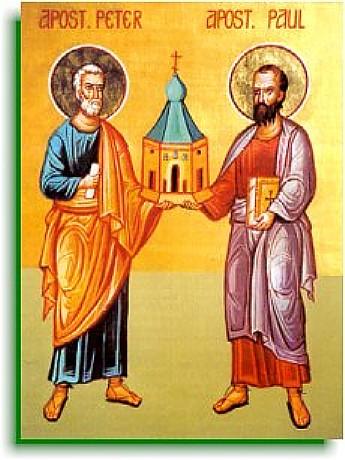|
|
|
Amigos w/ Common Interests
|
|
|
|
|
|
|
|
|
|
|
|
|
|
|
|
|
|
<<
View Prev Image
|
|
|
|
View Next Image >>
|

Category: Saints |
|
|
SOLEMNITY OF STS PETER AND PAUL
Homily of His Holiness Benedict XVI
Part TWO of THREE
The essential content of what is presented in detail in the complete Catechism, through the witness of the saints of all the ages and with reflections that have matured in theology, is summed up here in this book and must then be translated into everyday language and constantly put into practice. The book is in the form of a dialogue with questions and answers.
The 14 images associated with the various areas of faith are an invitation to contemplation and meditation. In other words, a visible summary of what the written text develops in full detail. At the beginning there is a reproduction of a 6th-century icon of Christ, kept at Mount Athos, that portrays Christ in his dignity as Lord of the earth but at the same time also as a herald of the Gospel which he holds in his hand. "I am who am", this mysterious name of God presented in the Old Testament, is copied here as his own name: all that exists comes from him; he is the original source of all being. And since he is one, he is also ever present, ever close to us and at the same time, ever in the lead: an "indicator" on our way through life, especially since he himself is the Way. This book cannot be read as if it were a novel. Its individual sections must be calmly meditated upon and, through the images, its content must be allowed to penetrate the soul. I hope that it will be received as such and become a reliable guide in the transmission of the faith.
We have said that the catholicity of the Church and the unity of the Church go together. The fact that both dimensions become visible to us in the figures of the holy Apostles already shows us the consequent characteristic of the Church: she is apostolic. What does this mean?
The Lord established Twelve Apostles just as the sons of Jacob were 12. By so doing he was presenting them as leaders of the People of God which, henceforth universal, from that time has included all the peoples. St Mark tells us that Jesus called the Apostles so "to be with him, and to be sent out" (Mk 3: 14). This seems almost a contradiction in terms. We would say: "Either they stayed with him or they were sent forth and set out on their travels". Pope St Gregory the Great says a word about angels that helps us resolve this contradiction. He says that angels are always sent out and at the same time are always in God's presence, and continues, "Wherever they are sent, wherever they go, they always journey on in God's heart" (Homily, 34, 13). The Book of Revelation described Bishops as "angels" in their Church, so we can state: the Apostles and their successors must always be with the Lord and precisely in this way - wherever they may go - they must always be in communion with him and live by this communion.
The Church is apostolic, because she professes the faith of the Apostles and attempts to live it. There is a unity that marks the Twelve called by the Lord, but there is also continuity in the apostolic mission. St Peter, in his First Letter, described himself as "a fellow elder" of the presbyters to whom he writes (5: 1). And with this he expressed the principle of apostolic succession: the same ministry which he had received from the Lord now continues in the Church through priestly ordination. The Word of God is not only written but, thanks to the testimonies that the Lord in the sacrament has inscribed in the apostolic ministry, it remains a living word. Thus, I now address you, dear Brother Bishops. I greet you with affection, together with your relatives and the pilgrims from your respective Dioceses. You are about to receive the Pallium from the hands of the Successor of Peter. We had it blessed, as though by Peter himself, by placing it beside his tomb. It is now an expression of our common responsibility to the "chief Shepherd" Jesus Christ, of whom Peter speaks (I Pt 5: 4). The Pallium is an expression of our apostolic mission. It is an expression of our communion whose visible guarantee is the Petrine ministry. Unity as well as apostolicity are bound to the Petrine service that visibly unites the Church of all places and all times, thereby preventing each one of us from slipping into the kind of false autonomy that all too easily becomes particularization of the Church and might consequently jeopardize her independence. So, let us not forget that the purpose of all offices and ministries is basically that "we [all] become one in faith and in the knowledge of God's son, and form that perfect man who is Christ come to full stature", so that the Body of Christ may grow and build "itself up in love" (Eph 4: 13, 16).
continued NEXT image |
|
|
|
|
|
| |
|
|
|
|